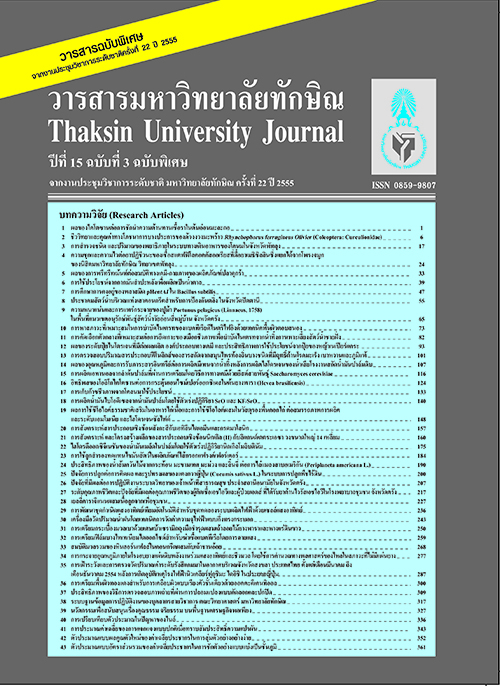เยลลี่คาราจีแนนผสมเนื้อลูกจากเพื่อชุมชน
Main Article Content
Abstract
งานวิจัยนี้เป็นการศึกษาวิธีการนำผลของต้นจาก (Nypa fruiticans Wrumb) ไปผลิตเป็นเยลลี่คาราจีแนน ผสมเนื้อลูกจาก โดยเริ่มจากวิเคราะห์องค์ประกอบพื้นฐานในเนื้อลูกจาก ได้แก่ เถ้า โปรตีน ไขมัน และคาร์โบไฮเดรต พบว่ามีปริมาณร้อยละ 0.64 1.66 0.50 และ 97.20 ตามลำดับ หลังจากนั้นศึกษาปริมาณที่เหมาะสมของคาราจีแนน ซึ่งทำให้เกิดเจล เพื่อใช้เป็นสูตรมาตรฐานสำหรับผลิตเยลลี่คาราจีแนนผสมลูกจาก การทดลองพบว่าการใช้ คาราจีแนน 1.8% w/v กรัม ในส่วนผสมอื่นๆ ได้แก่ ผงบุก 0.1 % w/v น้ำตาลทราย 30 % w/v เกลือ 0.25 % w/v และ กรดซิตริก 0.2 % w/v ได้รับการยอมรับจากผู้บริโภคซึ่งทดสอบโดยการชิมทางประสาทสัมผัสมากที่สุด และนำ สูตรมาตรฐานไปศึกษาการเติมปริมาณเนื้อลูกจากที่เหมาะสมพบว่าการใช้เนื้อลูกจาก 10% (เนื้อลูกจาก 5 กรัม และเนื้อเยลลี่ 45 กรัม)ได้รับการยอมรับจากผู้บริโภคสูงสุด จะเห็นได้ว่าการนำลูกจากมาแปรรูปให้เป็น ผลิตภัณฑ์เยลลี่เป็นแนวทางที่่น่าสนใจ ซึ่งผลิตภัณฑ์นี้อาจเป็นผลิตภัณฑ์ที่สามารถสร้างรายได้ให้แก่ชุมชน ป่าจากและบริเวณใกล้เคียงได้
This research investigates the method of using nipa palm (Nypa fruiticans Wrumb) fruits (NPF) to produce NPF-carrageenan jelly. The NPF was first analysed to determine its constituents; they comprise ash, protein, fat, and carbohydrate with 0.64, 1.66, 0.50 and 97.20%, respectively. Next, the suitable amount of carrageenan that forming gel was examined of which was used as a standard formula to produce the NPF-carrageenan jelly. It was found that an experimental mixture containing of 1.8% w/v carrageenan, 0.1% w/v conjac powder, 30% w/v sugar, 0.25% w/v salt, and 0.2% w/v g citric acid is most satisfied by the consumers when tasted. Subsequently, the standard formula was analysed in details; and, it was found that the mixture having 10% of NPF (5g NPF in 45g jelly) is most accepted by the consumers. This implies that the NPF has a high potential for being processed as jelly thereby increasing the income for communities around the nipa palm areas.


